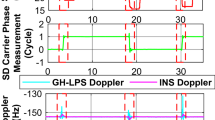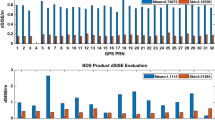Abstract
In the Global Positioning System, there is no provision for real-time integrity information within the Standard Positioning Service, by design. However, in safety critical sectors like aviation, stringent integrity performance requirements must be met. This can be achieved using the special augmentation systems or RAIM (Receiver Autonomous Integrity Monitoring) or both. RAIM, the most cost-effective method relies on data consistency, and therefore requires redundant measurements for its operation. An external aid to provide this redundancy can be in the form of an Inertial Navigation system. This should enable continued performance even when no redundant satellite measurements are available. An algorithm presented in previous papers by the authors detects the rate of slowly growing errors. The algorithm was shown to be effective for early detection of slowly growing errors that belong to the class of most difficult to detect errors. Firstly, rate detector is tested for varying faults. Secondly, real data are used to validate the rate detector algorithm. The data are extensively analyzed to ascertain whether it is suitable for integrity and fault diagnostics. A modification to the original rate detector algorithm is suggested by addition of a bias state to the dynamic model. The performance is then compared with the existing techniques and substantial improvement is shown.














Similar content being viewed by others
References
Bhatti UI (2007) Integrity of GPS/INS integrated systems in the presence of slowly growing errors, PhD thesis, Imperial College London
Bhatti UI, Ochieng WY (2007) Failure modes and models for integrated GPS/INS systems. J Navig 60(2):327–348
Bhatti UI, Ochieng WY (2009) Detecting multiple failures in GPS/INS integrated system: a novel architecture for integrity monitoring. J Glob Position Syst 8(1):26–42
Bhatti UI, Ochieng WY, Feng S (2007a) Integrity of an integrated GPS/INS system in the presence of slowly growing errors Part I: a critical review. GPS Solut 11(3):173–181
Bhatti UI, Ochieng WY, Feng S (2007b) Integrity of an Integrated GPS/INS system in the presence of slowly growing errors Part II: Analysis. GPS Solut 11(3):183–192
Brenner M (1995) Integrated GPS/inertial fault detection availability. In: Proceedings of the 9th international technical meeting of the satellite division of the institute of navigation, Institute of Navigation, Kansas city, Missouri, USA, pp 1949–1958
Brown RG (1992) A baseline GPS RAIM scheme and a note on the equivalence of three RAIM methods, Navigation. J Inst Navig 39(3):101–116
Clot A, Macabaiu C, Nikiforov I, Roturier B (2006) Sequential RAIM designed to detect combined step ramp pseudorange error. ION GNSS, TX, USA, pp 2621–2633
Diesel J, Dunn G (1996) GPS/IRS AIME: certification for sole means and solution to RF interference. In: Proceedings of the 9th international technical meeting of the satellite division of the institute of navigation, Institute of Navigation, Kansas City, Missouri, USA, pp 1599–1606
Gautier JD, Parkinson BW (2003) Using the GPS/INS generalized evaluation tool (comparison of loosely-coupled, tightly-coupled and ultra-tightly coupled integration navigation). In: Proceedings of the ION annual meeting, Albuquerque, NM, pp 65–76
Hide C, Blake S, Meng X, Gethins R, Moore T, Park D (2005) Investigation in the use of GPS and INS sensors for structural health monitoring. In: Proceedings of the ION GNSS, Institute of Navigation, USA, pp 2029–2038
ICAO SARPS (2004) Annex 10: international standards and recommended practices: aeronautical telecommunications, Volume 1, International Civil Aviation Organisation, Montreal
Lee YC, O’Laughlin DG (1999) A performance analysis of a tightly coupled GPS/inertial system for two integrity monitoring methods. In: Proceedings of the 12th international technical meeting of the satellite division of the Institute of Navigation. Institute of Navigation, Nashville, pp 1187–1200
Ochieng WY, Sauer K, Walsh D, Brodin G, Griffin S, Denney M (2003) GPS integrity and potential impact on aviation safety. J Navig 56:51–65
US Department of Defence (2001) Global positioning system standard positioning service performance standardm. US Department of Defence, USA
US Department of Transport (2001) Vulnerability assessment of the transportation infrastructure relying on the global positioning system. US Department of Transport, USA
Van Dyke K, Kovach K, Lavrakas J, Fernow JP, Carroll J, Kraemer J, Attallah N, Baevitz B (2003) GPS integrity failure modes and effects analysis. In: Proceedings of ION GPS/GNSS institute of navigation, Portland, Oregan, USA
Van Dyke K, Kovach K, Lavrakas J, Carroll B (2004) Status update on GPS integrity failure modes and effect analysis. In: Proceedings of ION national technical meeting, San Diego, California, USA
Walsh D, Loannides R, Ochieng WY, Feng S (2004) GPS failure modes and effects analysis. In: Proceedings of NAV 04 location and timing applications- GNSS and AIS, NAV 04 London, UK
Acknowledgments
The authors acknowledges the financial support of Government of Pakistan, Imperial College London and Dr. Imran Iqbal Bhatti. The real GPS and INS data used in this paper was provided by the SPACE project- a consortium involving Imperial College London, the University of Nottingham, UCL an the University of Leeds. The assistance rendered by Dr. Chris Hide (IESSG, Nottingham) with data manipulation and simulation, in acknowledged.
Author information
Authors and Affiliations
Corresponding author
Rights and permissions
About this article
Cite this article
Bhatti, U.I., Ochieng, W.Y. & Feng, S. Performance of rate detector algorithms for an integrated GPS/INS system in the presence of slowly growing error. GPS Solut 16, 293–301 (2012). https://doi.org/10.1007/s10291-011-0231-y
Received:
Accepted:
Published:
Issue Date:
DOI: https://doi.org/10.1007/s10291-011-0231-y




